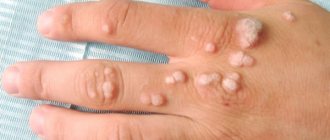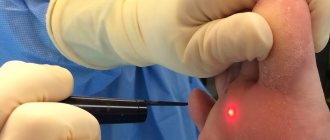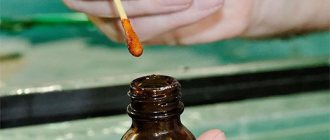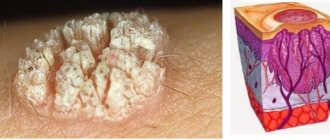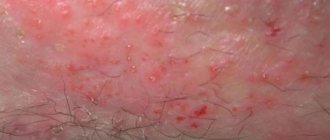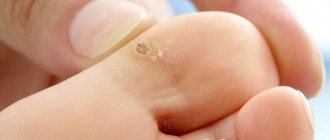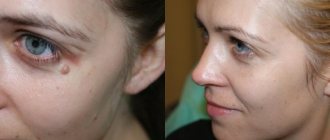A subungual wart is a fairly rare occurrence. Most often, such formations appear on the backs of the palms and soles of the feet. But accidental injuries and improperly performed manicure can trigger the appearance of these elements around and under the nails.
Periungual warts are always a consequence of the penetration of the papillomavirus into the body, which, unfortunately, is extremely common and is present in eight out of ten people.
Causes of subungual warts
The human papillomavirus is responsible for the occurrence of warts of any localization. Infection occurs through contact and household contact through damaged skin. With good immunity, the virus can remain dormant in the body for a long time.
But with a decrease in protective forces, it turns into an active form and causes the development of warts and papillomas. Additionally, various provoking factors may contribute to this.
A wart on the hand near the nail often occurs in the following situations:
- in the presence of hangnails;
- after cuts and injuries to the skin of the fingers;
- due to the habit of biting nails;
- in case of errors during manicure (cuts, injuries, use of contaminated tools);
- after skin irritation with chemicals, including household chemicals.
A wart on the foot under the nail develops after the action of the following provoking factors:
- wearing tight, uncomfortable or rough shoes;
- visiting the pool, bathhouse or sauna barefoot;
- wearing someone else's shoes.
Increased sweating and ingrown toenails also contribute to the occurrence of periungual warts on the feet.
Kinds
Papillomas appear due to a viral infection or due to age-related changes in the skin. Popular types of warts that are located around or under the nails are vulgar or juvenile papillomas.
Ordinary papillomas are dome-shaped and have a dirty-brown color. Simple warts look like the top of a cauliflower. Small solitary papillomas tend to merge and form large, lumpy papillomas.
The juvenile type of warts differs from the flat type in that they have the appearance of a node, are grayish-yellow in color, and can often be grouped in the event of an abrasion or cut.
Symptoms of warts
Typically, warts are round-shaped formations that do not rise much above the skin. Their surface is initially smooth, but over time it becomes rough and becomes covered with horny growths. The skin pattern disappears.
There are two types of such formations on the fingers near the nails:
- subungual wart (located under the nail);
- periungual or periungual wart (on the cuticle near the nail).
In the first case, the element is located under the nail. It may be small and indistinguishable in color from the surrounding skin. In such cases, they are absolutely invisible and do not cause inconvenience. Problems begin when a wart under a fingernail or toenail begins to grow.
This first provokes thinning of the nail plate, and then its deformation and destruction. Moreover, a wart under the toenail, due to compression by shoes, can be very painful and lead to lameness of the patient or limited mobility.
With such a pathology, you should definitely contact a dermatologist for diagnosis and treatment.
A periungual or periungual wart is a wart near the fingernail or toenail. Its appearance usually does not go unnoticed, since it is a growth that rises to one degree or another above the level of the skin.
Nail warts can be flat or have a deep root. In the latter case, the elements during growth spread to the adjacent nail, causing its damage, deformation and destruction.
When examining warts in detail, you can notice small dark dots and stripes on them, which are actually thrombosed capillaries.
On the hand near the nail, a wart can often become injured during everyday work and bleed. On the feet, the same thing happens when there is pressure from shoes or when there are rough seams in the toe area.
Due to frequent damage, these warts may appear darker in color than the surrounding skin. In such situations, there is always a risk of infection, which is a good reason to consult a doctor for help.
Removal methods
These growths can lead to disastrous consequences if they are not treated promptly.
Infection of healthy tissue may occur. Virus and bacteria enter through small cracks and injuries. This situation can occur due to wearing small or tight shoes for a long time, due to constant biting of hangnails and nails. Thinning of the nail plate may occur.
Medication
Modern pharmacies have a wide selection of products that are designed to remove warts at home.
Many of these products are sold without a prescription, but experienced professionals insist on consulting a doctor before removing warts.
Among the effective treatments for warts that are located near or under the nails are the following:
Salipod patch
Aldara cream
Viferon
Feresol solution
Collomak
Super clean
Isoprinosine tablets
Panavir gel
medical pencil Lapis
You can find instructions for using these drugs on our website, using the search or in this section.
Hardware
The hardware method of treating warts is the most effective. Using a laser, you can completely remove the area with the wart, and then the skin evens out on its own (after 2-3 weeks).
It is necessary to cauterize with a laser layer by layer, in special situations it is necessary to cauterize several times.
Doctors call this method the most aesthetic, since it does not leave visible scars.
Cryotherapy is a type of wart removal using special equipment. This method is used by children, diabetics and pregnant women. It is 100% effective, but scars and relapses may appear, you need to be careful.
Using electrocoagulation, the area of skin with papilloma is cut off (that is, under the influence of high-frequency current). This method of wart removal involves no bleeding and a very low rate of possible infection. Efficiency up to 95% .
Folk remedies
Traditional medicine has many recipes that are intended for the treatment of subungual papillomas.
You need to be careful in choosing one method or another, you need to take into account the individuality of each organism and objectively assess the situation.
Below are examples of traditional medicine.
- 8 onion compress. Fresh onions or grated onions should be applied to the wart as a compress. The procedure must be done until the growth disappears. Speed up the process with table vinegar.
- Garlic ointment. Garlic should be grated and mixed in a 1:1 ratio with butter. The resulting mixture should be rubbed or applied to the papilloma before going to bed. More recipes here.
- Celandine juice. The juice should be dripped onto the wart using a pipette. If the juice gets on healthy skin, it may cause a burn. Read how to use it in this article.
- Vinegar compress. The vinegar needs to be mixed with flour and stirred until it reaches the consistency of an ointment. The resulting mixture should be applied to the papilloma. It is important not to get it on the nail plate or healthy skin.
Diagnostics
Warts of this localization can be confused with other pathologies. Therefore, it is better to entrust the diagnosis and choice of therapeutic tactics to a doctor and not self-medicate.
For a competent dermatologist to make a diagnosis, it is enough to examine the skin formations. In some cases, additional research may be necessary.
Warts around the nails are very similar to calluses. The main difference between them is the preservation of the skin pattern on the surface of the calluses and the absence of thrombosed capillaries (black dots on the surface) in their structure upon visual inspection.
Warts under the nail cause its destruction, which is clinically very similar to a fungal infection (photos of these pathologies in the medical literature are practically the same). But a negative culture for fungi will quickly clarify the situation in terms of the etiology of the disease.
If necessary, the doctor will additionally prescribe a dermatoscopy and biopsy of the formation.
Treatment of warts
Official medicine offers many ways to get rid of warts near and under the nails. Conventionally, all of them can be divided into two large groups: conservative therapy and surgical removal.
Conservative treatment of warts
Conservative therapy involves taking antiviral and immunostimulating drugs orally and local treatment.
Warts are a viral disease. Therefore, the use of drugs that inhibit viruses is completely justified. For this purpose, doctors prescribe Cycloferon, Anaferon, Isoprinosine, etc.
In case of reduced immunity, the use of immunostimulating and immunomodulating agents is indicated. You should take such medications only as prescribed by your doctor.
External remedies for warts
The most common treatments for warts are topical medications. Depending on the number of elements, their size and location, medications from different groups are used:
- immunomodulators (Imiquimod);
- based on acids with a necrotizing effect (Solcoderm, Verrukacid);
- antiviral (Viferon);
- refrigerants (Cryopharma);
- keratolytic agents (salicylic acid and ointment, Collomac).
Small and superficial elements can be removed using these drugs. In order to get rid of large, deep or old warts, you have to resort to surgical methods.
Surgery
If you can’t get rid of warts using conservative methods, but you still don’t want to live with them, surgery with its radical but gentle techniques comes to the rescue. These include:
- laser removal;
- removal using the Surgitron apparatus (radio wave knife);
- cryodestruction;
- electrocoagulation.
These manipulations are performed by a dermatologist on an outpatient basis. A few minutes after the procedure, the patient can go home. The rehabilitation period varies in time depending on the method used by the doctor to remove periungual warts.
But the features of caring for the wound surface are similar for all methods - you cannot peel off the formed crust, the skin must be treated with antiseptic and antibacterial agents.
In some cases, excision of the wart with a scalpel is required. This operation is performed only by surgeons. After it there is always a long rehabilitation and a high risk of scarring, so it is prescribed only for serious indications.
Types of warts
In shape, growths in children can be round, thread-like, oval or asymmetrical. Doctors distinguish several types of warts, which differ in color, size, and structure:
- Vulgar:
most often formed on the hands and can be either single or in the form of merging clusters. They look like small, towering growths with a rough surface and clear contours. - Palmoplantar:
Large growths on the soles or palms that resemble calluses. Usually they are single and grow deeply into the tissue, forming painful growths with a rigid structure. - Juvenile:
can occur on any part of the body. Their distinctive features are their uneven shape, smooth surface and rapid keratinization. - Pointed:
grow on the mucous membranes and look like rounded formations, similar to cauliflower.
Diagnostics
Before starting treatment for warts, the doctor performs an external examination of the child and determines the type of tumor. In some cases, the patient may be referred for a biopsy (if there is a suspicion of oncology) or for a PCR test (a method that detects the DNA of the HPV pathogen in a person’s blood). To clarify the diagnosis, dermatoscopy is performed.
Wart removal methods
Treatment of warts includes a set of measures aimed at suppressing the activity of the virus and safely removing growths. Viral warts are often accompanied by increased sweating. In such situations, additional therapy is prescribed to get rid of excessive sweating.
To remove warts in children, the safest and most painless methods are chosen:
- cryodestruction – helps remove growths by freezing them with liquid nitrogen;
- chemical destruction - performed by treating formations with alkali or acid (used only for children over 12 years old);
- electrocoagulation – exposure to electric current;
- radio wave method using the Surgitron apparatus - eliminates warts due to the action of radio waves;
- micropulse laser PinPointe FootLaser – eliminates skin formations using a laser beam.
Laser removal of warts in children
At the Podology Clinic, warts are removed from children using the unique and only laser device in Moscow, PinPointe FootLaser.
A micropulse laser cuts and seals the capillaries that feed the wart, it stops growing and after some time dries up and falls off. Laser therapy is an absolutely painless and effective method for removing skin tumors! Several sessions will allow you to get rid of small elements forever without burns or relapses; large ones will require at least 3-4 visits to the doctor. Our center employs qualified dermatologists who will painlessly remove any type of formation. An individual approach, the use of modern laser equipment, innovative treatment methods that are painless and safe – these are the advantages of the clinic that will effectively solve any dermatological problem in a child.
Features of subungual warts in children
Warts are more common in children than in adults. This is due to the immaturity of the immune system and frequent skin injuries. At the same time, self-resolution of such elements is also observed more often in them than in adults.
Most wart removal methods are quite painful. Therefore, parents of children are in no hurry to consult doctors, but resort to traditional medicine methods. This is not the best option.
There is little chance of getting rid of warts through self-medication, but it is quite possible to end up with deformation and destruction of the nail plate.
If a child has a single wart that does not bother him in any way, you don’t have to take any action, but just wait. There is a chance that it will disappear on its own.
But you should definitely see a doctor if:
- there are many warts;
- they grow;
- are injured and bleed;
- new elements continue to appear;
- There are doubts that this is a wart.
If any of these conditions occur, you should not put off visiting a dermatologist.
How to prevent the formation of subungual warts
Prevention of this pathology, first of all, comes down to following the rules of personal hygiene:
- you cannot walk barefoot in public places;
- It is not recommended to wear someone else’s shoes, socks, tights, gloves, etc.;
- manicures and pedicures should be done only in trusted places, where all necessary processing of instruments is carried out after each client;
- Do not bite your nails or hangnails;
- In case of cuts, you should immediately treat the wounds with antiseptics.
In the case of frequently recurring warts, you should definitely consult an immunologist and check your immunogram. You may need to take immunomodulatory drugs to stimulate the body's defenses.
Warts around and under nails are rare. Most often, they do not cause any inconvenience other than aesthetic discomfort. Fortunately, medicine offers many ways to get rid of these formations on the skin quickly and without a trace.
Reasons for education
The main reasons for the appearance and activation of warts include the following groups of factors:
- Direct contact with a person who is a carrier of the papilloma virus;
- Infection through household appliances, such as towels or bed linen, or through various surfaces, such as handrails in transport and others. There is a greater chance of contracting papilloma due to microtraumas on the skin;
- Long nervous situations;
- Weakened immunity;
- Chronic diseases with frequent exacerbations.
